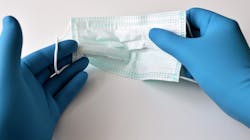National survey shows healthcare facilities are implementing PPE crisis standards of care
As cases of COVID-19 surge in the U.S., a national survey of infection prevention experts, conducted Oct. 22 to Nov. 5, 2020 by the Association for Professionals in Infection Control and Epidemiology (APIC), found that while healthcare personnel have better access to personal protective equipment (PPE) than they did in the spring, many healthcare facilities have implemented PPE crisis standards of care, announced the association.
The online survey of 1,083 infection preventionists (IPs) located in U.S. hospitals and health facilities found that 73.0 percent of respondents reported that their healthcare facilities have implemented PPE crisis standards of care for respirators, 68.7 percent for masks, and 75.8 percent for face shields or eye protection. This means healthcare personnel are reusing or extending the life of PPE traditionally meant for single use.
For those who reuse respirators or masks, three-quarters (75.9 percent) of respondents said that their healthcare facilities allow staff to reuse their respirator either five times or as many times as possible before getting a new respirator. Nearly three-quarters (73.6 percent) of respondents said that their facilities allow staff to reuse their masks either five times or as many times as possible before getting a new mask.
“It is disheartening to see our healthcare system strained and implementing PPE crisis standards of care more than eight months into the pandemic,” said 2020 APIC President, Connie Steed, MSN, RN, CIC, FAPIC. “Many of us on the frontlines are waiting for the other shoe to drop. With the upcoming flu season, we implore people to do what they can to keep safe, protect our healthcare personnel, and lessen the strain on our healthcare system: wear a mask, get your flu shot, wash your hands, and maintain social distancing from others to slow the spread of COVID-19.”
Respondents also reported an increase in healthcare-associated infections at their facilities since the pandemic began, with 27.8 percent reporting specific increases in central line-associated bloodstream infections (CLABSI), 21.4 percent in catheter-associated urinary tract infections (CAUTI), and 17.6 percent in ventilator-associated pneumonia (VAPs) or ventilator-associated events (VAEs).
The survey also asked IPs about possible medical supply shortages and capacity issues during the confluence of the pandemic and the 2020/2021 flu season. Nearly three quarters (72 percent) are strongly (35 percent) or somewhat (37 percent) concerned about their facility’s surge capacity; more than half of respondents (54 percent) are strongly (23 percent) or somewhat (31 percent) concerned about their facility’s ability to provide safe care. Nearly 80 percent of respondents said that they are concerned about the impact of medical supply shortages in their healthcare facility related to the current flu season, and 84percent are more concerned about supply shortages compared to previous years because of the pandemic.
IPs develop evidence-based practices to prevent the spread of infection, including protocols for hand hygiene and the proper use of PPE. This is the second survey APIC conducted on access to PPE. A March 2020 survey found that nearly half (48 percent) of U.S. healthcare facilities surveyed were either already out of or almost out of respirators to use in caring for a patient with COVID-19.
